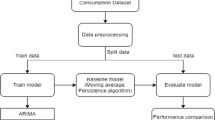Abstract
Prediction of power consumption is an integral part of the operation and planning of the electricity supply company. In terms of power supply and demand, For the stable supply of electricity, the reserve power must be prepared.
However, it is necessary to predict electricity demand because electricity is difficult to store. In this paper, we propose a CNN-LSTM hybrid network that can extract spatio-temporal information to effectively predict the house power consumption. Experiments have shown that CNN-LSTM hybrid networks, which linearly combine convolutional neural network (CNN), long short-term memory (LSTM) and deep neural network (DNN), can extract irregular features of electric power consumption. The CNN layer is used to reduce the spectrum of spatial information, the LSTM layer is suitable for modeling temporal information, the DNN layer generates a predicted time series. The CNN-LSTM hybrid approach almost completely predicts power consumption. Finally, the CNN-LSTM hybrid method achieves higher root mean square error (RMSE) than traditional predictive methods for the individual household power consumption data sets provided by the UCI repository.
Access this chapter
Tax calculation will be finalised at checkout
Purchases are for personal use only
Similar content being viewed by others
References
Cho, S.-B., Yu, J.-M.: Hierarchical modular Bayesian networks for low-power context-aware smartphone. Neurocomputing (2017)
Kant, G., Sangwan, K.S.: Prediction and optimization of machining parameters for minimizing power consumption and surface roughness in machining. J. Clean. Prod. 83, 151–164 (2014)
Hernandez, L., et al.: A survey on electric power demand forecasting: future trends in smart grids, microgrids and smart buildings. IEEE Commun. Surv. Tutor. 16(3), 1460–1495 (2014)
Nychis, G., Sekar, V., Andersen, D.G., Kim, H., Zhang, H.: An empirical evaluation of entropy-based traffic anomaly detection. In: Proceedings of the 8th ACM SIGCOMM Internet Measurement Conference, pp. 151–156 (2008)
Münz, G., Li, S., Carle, G.: Traffic anomaly detection using k-means clustering. In: GI/ITG Workshop MMBnet (2007)
Zhang, J., Zulkernine, M.: Anomaly based network intrusion detection with unsupervised outlier detection. In: IEEE International Conference on Communications, vol. 5, pp. 2388–2393 (2006)
Ince, T., Kiranyaz, S., Eren, L., Askar, M., Gabbouj, M.: Real-time motor fault detection by 1-D convolutional neural networks. IEEE Trans. Ind. Electron. 63(11), 7067–7075 (2016)
Kiranyaz, S., Ince, T., Gabbouj, M.: Real-time patient-specific ECG classification by 1-D convolutional neural networks. IEEE Trans. Biomed. Eng. 63(3), 664–675 (2016)
Souza, V.M., Silva, D.F., Batista, G.E.: Extracting texture features for time series classification. In: 22nd International Conference on Pattern Recognition, pp. 1425–1430 (2014)
Bontemps, L., Cao, V.L., McDermott, J., Le-Khac, N.-A.: Collective anomaly detection based on long short-term memory recurrent neural networks. In: Dang, T.K., Wagner, R., Küng, J., Thoai, N., Takizawa, M., Neuhold, E. (eds.) FDSE 2016. LNCS, vol. 10018, pp. 141–152. Springer, Cham (2016). https://doi.org/10.1007/978-3-319-48057-2_9
Taylor, A., Leblanc, S., Japkowicz, N.: Anomaly detection in automobile control network data with long short-term memory networks. In: Analytics IEEE International Conference on Data Science and Advanced, pp. 130–139 (2016)
Malhotra, P., Vig, L., Shroff, G., Agarwal, P.: Long short term memory networks for anomaly detection in time series. In: European Symposium on Artificial Neural Networks, Computational Intelligence, p. 89 (2015)
Ronao, C.A., Cho, S.B.: Human activity recognition with smartphone sensors using deep learning neural networks. Expert Syst. Appl. 59, 235–244 (2016)
Kim, T.Y., Cho, S.-B.: Web traffic anomaly detection using C-LSTM neural networks. Expert Syst. Appl. 106, 66–76 (2018)
Loginov, A., Heywood, M.I., Wilson, G.: Benchmarking a coevolutionary streaming classifier under the individual household electric power consumption dataset. In: IEEE International Joint Conference on Neural Networks, pp. 2834–2841 (2016)
Acknowledgement
This research was supported by Korea Electric Power Corporation. (Grant number: R18XA05).
Author information
Authors and Affiliations
Corresponding author
Editor information
Editors and Affiliations
Rights and permissions
Copyright information
© 2018 Springer Nature Switzerland AG
About this paper
Cite this paper
Kim, TY., Cho, SB. (2018). Predicting the Household Power Consumption Using CNN-LSTM Hybrid Networks. In: Yin, H., Camacho, D., Novais, P., Tallón-Ballesteros, A. (eds) Intelligent Data Engineering and Automated Learning – IDEAL 2018. IDEAL 2018. Lecture Notes in Computer Science(), vol 11314. Springer, Cham. https://doi.org/10.1007/978-3-030-03493-1_50
Download citation
DOI: https://doi.org/10.1007/978-3-030-03493-1_50
Published:
Publisher Name: Springer, Cham
Print ISBN: 978-3-030-03492-4
Online ISBN: 978-3-030-03493-1
eBook Packages: Computer ScienceComputer Science (R0)




